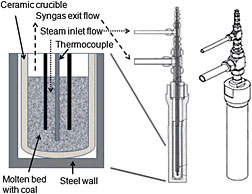- Number 374 |
- October 22, 2012
Coal gasification demonstrated

Molten catalytic reactor design. Steam and
coal react in a bed of molten alkali salts.
Isometric and cutaway views.
(Furnace not shown.)
DOE's National Energy Technology Laboratory (NETL) has developed a molten catalytic process for converting coal into a synthesis gas consisting of roughly 20% methane and 80% hydrogen using alkali hydroxides as both gasification catalysts and in situ CO2 and hydrogen sulfide (H2S) capture agents. This hydrogen- and methane-rich output from the gasifier could be sent to gas turbines or solid oxide fuel cells in order to generate electricity with CO2 emissions significantly less than 1.0 lbs of CO2 per kWh of electricity.
A patent application on this topic has been submitted and a paper entitled “Molten Catalytic Coal Gasification With In Situ Carbon and Sulphur Capture” was published by the Royal Society of Chemistry’s journal Energy & Environment Science.
Baseline studies were conducted using no catalyst, weak capture agents (calcium silicate), and a strong in situ capture agent for acid gases (calcium oxide-CaO). Parametric studies were conducted to understand the effects of temperature, pressure, catalyst composition, steam flow rate and the ratio of coal to alkali hydroxide on the performance of the molten catalytic gasifier in terms of kinetics and syngas composition.
To measure the amount and the rate of coal conversion, the researchers developed a method for quantifying the coal conversion related to the chemical oxygen demand remaining in the coal. This method was necessary because the capture reactions and the water condenser before the mass spectrometer make a real-time elemental balance impossible.
For many different reforming, gasification, and combustion experiments, measuring the change in the chemical oxygen demand of coal/fuel can be a more useful definition of coal/fuel utilization than measuring the change in the weight of the coal/fuel or measuring the change in carbon content of the coal/fuel.[Linda Morton, 304.285.4543,
Linda.morton@netl.doe.gov]
